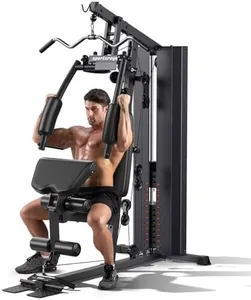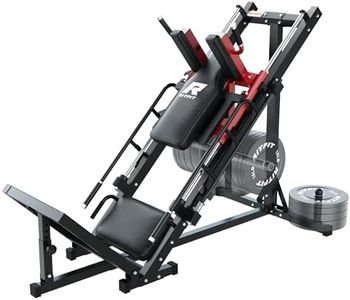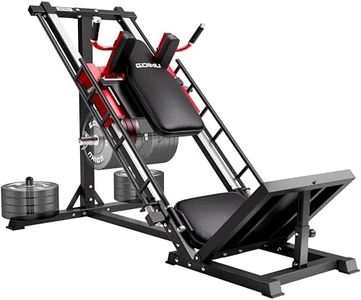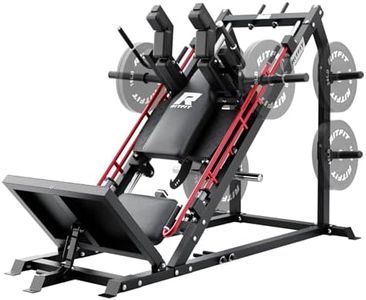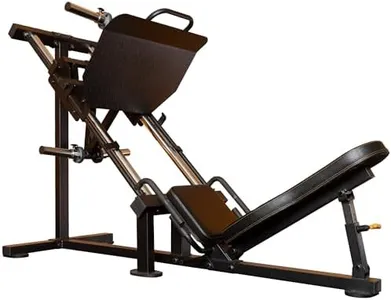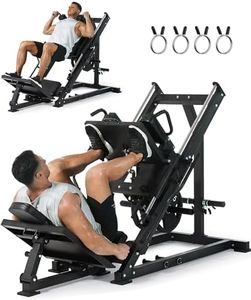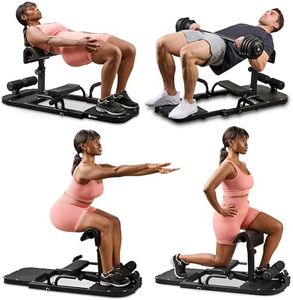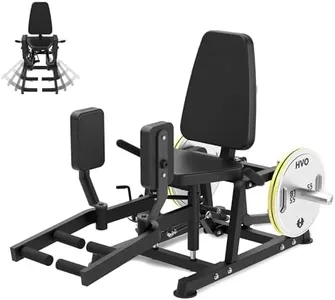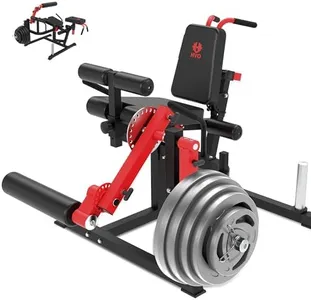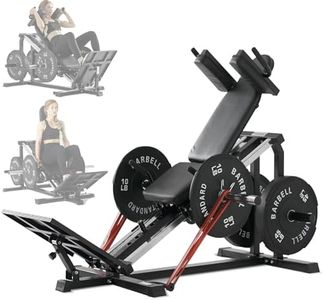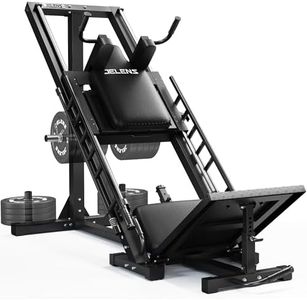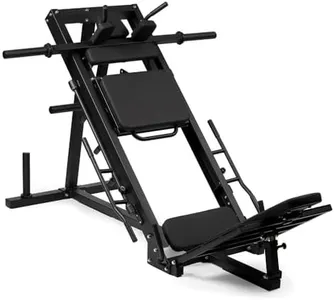9 Best Leg Press Machines 2025 in the United States
Our technology thoroughly searches through the online shopping world, reviewing hundreds of sites. We then process and analyze this information, updating in real-time to bring you the latest top-rated products. This way, you always get the best and most current options available.

Our Top Picks
Winner
RitFit Leg Press Hack Squat Machine, Professional Adjustable Leg Press Machine for Home Gym with Linear Bearing, Specialty Hack Squat for Full Lower Body Workout with Weight Storage, Red
Most important from
281 reviews
The RitFit Leg Press Hack Squat Machine offers a versatile solution for home gym enthusiasts looking to enhance their lower body workouts. This machine combines both leg press and hack squat exercises, making it suitable for a comprehensive lower body training regimen. With a high weight capacity of 1200 lbs, it's well-suited for both beginners and more advanced users, ensuring it can accommodate a wide range of fitness levels.
One of its key strengths is its build quality, made from heavy-duty alloy steel with linear bearings, which not only ensures durability but also stability during workouts. The additional weight plate storage adds to its stability, making it a reliable piece of equipment. The machine provides multiple adjustments, offering five angle options for hack squats and three for leg press, which is ideal for tailoring the workout to individual needs and sizes.
Comfort is also a priority with this machine. It features thick shoulder and backrest cushions covered in anti-slip, wear-resistant leather, which helps reduce strain on joints and enhances the exercise experience. The aluminum alloy grips and solid metal guide rods further contribute to a smooth, jerk-free workout.
Potential users should consider the space requirements, as this is a robust piece of equipment that might demand a significant footprint in a home gym setting. Additionally, the machine is shipped in two separate packages, which may result in staggered delivery.
While the RitFit offers a range of features aimed at both comfort and safety, such as a large footplate to prevent slipping and a back support designed for stability, its versatility and adjustability stand out as key benefits for those looking to diversify their lower body workouts at home. With a lifetime limited warranty, this machine is a strong contender for anyone serious about building their leg strength.
Most important from
281 reviews
GOIMU Leg Press Hack Squat Machine Combo, 4 in 1 Adjustable Leg Press Machine with Quad Track Roller System, Hack Squat Machine for Full Lower Body Workout with Weight Storage Posts, L2-R Version
Most important from
12 reviews
The GOIMU Leg Press Hack Squat Machine Combo offers a versatile lower body workout solution, combining both leg press and hack squat functionalities in a single piece of equipment. This 4-in-1 machine is designed for users ranging from 5 to 6 feet tall and focuses on targeting the quads, hamstrings, glutes, and calves while minimizing strain on the lower back. The ergonomic design features thick, comfortable cushions and premium anti-slip leather to ensure a supportive experience during intense workouts.
The machine is built with high-quality materials like alloy steel and aluminum, which contributes to its stability and durability. It can handle substantial weights, with a maximum capacity of 1200 pounds, making it suitable for both beginners and advanced lifters. Adjustability is a key feature, with multiple hack squat angles and leg press settings to tailor the workout to individual needs. Safety is addressed through a large, non-slip footplate, dual cushioning to absorb impact, and reinforced back support.
The compact size (70 x 42 inches) is practical for home gyms, although it may still require a dedicated space. One downside is the lack of warranty, which might be a concern for long-term investment.
Most important from
12 reviews
GMWD Leg Press Hack Squat Machine Combo, Leg Press Machine with Linear Bearing, Lower Body with Weight Storage for Quads, Hamstring, Glutes, Home Gym Exercise Equipment
Most important from
276 reviews
The GMWD Leg Press Hack Squat Machine is a versatile piece of equipment designed for serious lower body workouts. As a 2-in-1 machine, it effectively targets quads, hamstrings, glutes, and calves, making it ideal for individuals looking to enhance their leg day routine at home. With a high weight capacity of 385 pounds and the ability to handle up to 1500 pounds, it caters well to both novice and advanced users. The linear bearing structure enhances stability, ensuring smooth movements while reducing the risk of back strain. The adjustable seat and backrest provide additional comfort, which is essential for longer workout sessions.
This machine does have some considerations to keep in mind. Its significant footprint of 84” x 38” means it requires ample space, making it less suitable for smaller home gyms. Additionally, the overall weight of 385 pounds could pose challenges for moving or adjusting the machine without assistance. While the safety features, such as multiple lockout positions and height choices, add a layer of security, users may need to familiarize themselves with these settings to optimize their workouts safely.
The GMWD Leg Press Hack Squat Machine is well-suited for fitness enthusiasts who want a durable and effective way to build lower body strength. Its robust build quality and comfort features make it a strong contender in the market, though potential buyers should ensure they have sufficient space and support for this heavy-duty equipment.
Most important from
276 reviews
Buying Guide for the Best Leg Press Machines
Choosing the right leg press machine can significantly enhance your lower body workout routine. A leg press machine allows you to perform exercises that target your quadriceps, hamstrings, glutes, and calves. When selecting a leg press machine, it's important to consider several key specifications to ensure it meets your fitness goals, space requirements, and comfort needs. Understanding these specifications will help you make an informed decision and get the most out of your investment.FAQ
Most Popular Categories Right Now
